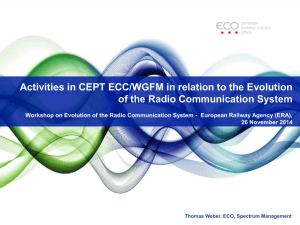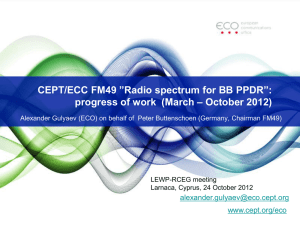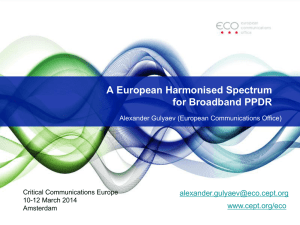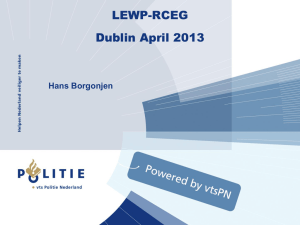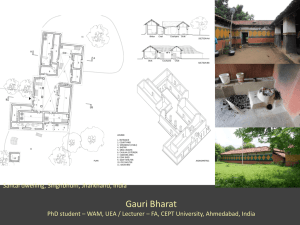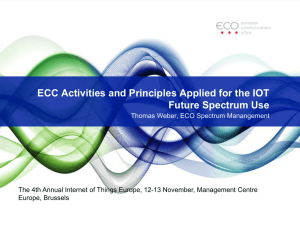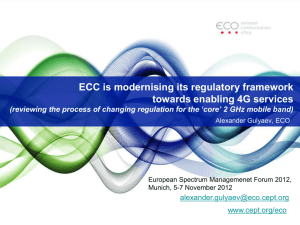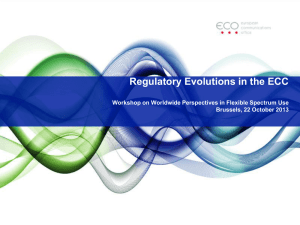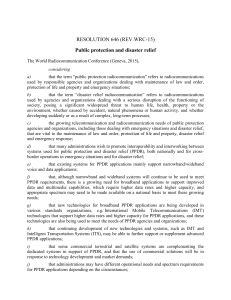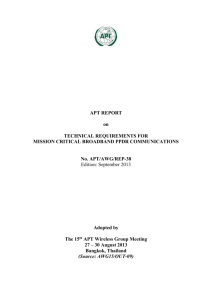Identifying a European harmonised solution for Broadband
advertisement
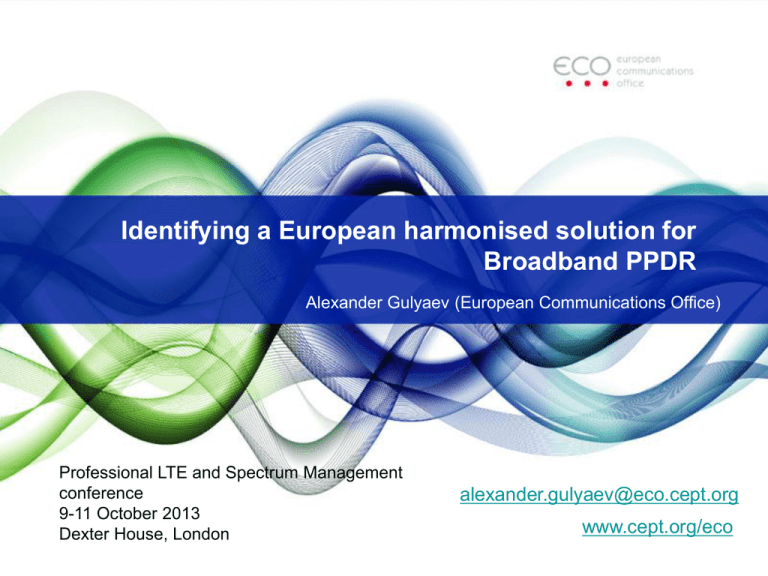
Identifying a European harmonised solution for Broadband PPDR Alexander Gulyaev (European Communications Office) Professional LTE and Spectrum Management conference 9-11 October 2013 Dexter House, London alexander.gulyaev@eco.cept.org www.cept.org/eco European regulatory framework for radio spectrum and equipment Read more at http://apps.cept.org/ eccetsirel/ Roles of the three European regulatory organizations European Commission: Single market issues Binding regulations based on the technical expertise of CEPT/ECC and harmonised standards of ETSI (28 Member States) CEPT/ECC: Consensus and voluntary character Spectrum designation to systems/applicatoins and technical conditions for its use (48 member countries) ETSI: European Harmonised standards (EN) for radio equipment ‘System Reference Documents’ (SRDoc) which inform and trigger much of the CEPT/ECC work (over 700 industry members and European naitonal regulators) Regulatory actors on the scene of broadband PPDR harmonisation European Commission CEPT FM49 LEWP-RCEG Justice and Home Affairs European Council TETRA + Critical Communications Association International Telecommunication Union (ITU) ITU is the United Nations agency for ICT ITU-R Working Party 5A is responsible for Agenda Item 1.3 of WRC-15 (revision of regulatory provisions for PPDR, including regionally harmonised frequency bands) ITU-R WP 5A acts as a global architect for shaping future look of broadband PPDR communications ITU-R WP5D “IMT Systems” addresses the PPDR needs from the IMT technologies perspective European Commission European Commission is setting out policy priorities and long-term objectives for wireless broadband, including Public Safety Radio Spectrum Policy Programme (RSPP): Article 8.3: The Commission shall, in cooperation with the Member States, seek to ensure that sufficient spectrum is made available under harmonised conditions to support the development of safety services and the free circulation of related devices as well as the development of innovative interoperable solutions for public safety and protection, civil protection and disaster relief. LEWP-RCEG (Home and Justice Affairs, European Council) Radio Communications Expert Group of the Law Enforcement Working Party is composed of senior representatives from PPDR agencies and regulatory authorities of EU and EFTA Members LEWP-RCEG adopts statements setting out mid- to long-term objectives based on the needs of European PPDR community • Statement of LEWP-RCEG (October 2012): LEWP-RCEG asks ECC/CEPT WGFM to take into account the PPDR needs for a mission critical Broadband solution and for this purpose to allocate harmonised frequencies ETSI European Telecommunications Standards Institute develops Harmonised Standards (EN) for telecommunication equipment, including for Public Safety ETSI is also developing Technical Reports (TR) which both support ETSI’s standardization work and CEPT’s spectrum management activities (as SRDoc): • ETSI TR 102 628 (SRDoc) on additional spectrum requirements for public safety and security in the UHF frequency range • New (draft) Work Item in TETRA TC aimed at updating TR 102 628 to include more detailed calculations to justify the requirements, and to reflect the changes in the external environment 3GPP 3GPP provides technical environment for producing LTE specifications, including for Public Safety 3GPP TSG Service and System Aspects (TSG-SA) is working on the inclusion of PPDR specific features in 3GPP Release 12 (target date: September 2014), namely: • Mission critical voice and data PTT group communication capability (GCSE_LTE), and • Direct device-to-device communications (ProSe*) * It is likely that not all ProSe functionality will be included in 3GPP Rel-12; some of the remaining functions will be specified in later 3GPP releases TETRA + Critical Communications Association (TCCA) TCCA is a forum for all professional users, both Public Safety (mission critical) and Utilities & Transport (business users) TCCA is developing community’s: • user requirements • systems and architectures, and • business cases TCCA is communicating its needs from “first hands” to regulatory bodies (first of all, to CEPT), to ensure timely allocation of sufficient resources CEPT groups dealing with Broadband PPDR CEPT ECC Plenary WG FM WG SE FM49 ECC PT1 CPG PTD CPG PTA ECC ”Strategic Plan” Priority topics: • Digital dividend • Cognitive radio • Public Protection and Disaster Relief (PPDR) • Innovation above 40 MHz • Numbering and naming • Improve its own working processes CEPT groups dealing with Broadband PPDR CEPT ECC Plenary WG FM WG SE FM49 ECC PT1 CPG PTD CPG PTA Roadmap of the FM49 work FM49 is the PPDR specialist project team of CEPT (chairman Mr Peter Buttenschoen, BMWi, Germany) FM49’s main task: find harmonised radio spectrum for future European broadband PPDR systems • ECC Report ”A” (requirements) – May 2013 ECC Report ”B” (solutions) – planned for early 2015 • Support to ECC PT1 on PPDR parameters for CEPT Report in response to EC Mandate on 700 MHz • Support to CPG PTA in the CEPT preparatory work on Agenda Item 1.3 of WRC-15 FM49’s progress of work (1) ECC Report 199 (“A”) “User requirements and spectrum needs for future European broadband PPDR systems (Wide Area Networks)” approved in May 2013: Conslusions: Assumptions: •• • •• • minimum applications: requirement LEWP/RCEG-ETSI of 2x10 MHz “Matrix for Wide of applications” Area Networks but scenarios: nationalLEWP/RCEG needs may vary PP1 to and a significant PP2 based extent scenarios more technology: spectrum LTEmay be needed to meet the different requirements frequency ranges: for voice, 700 MHz Directand Mode 400Operations MHz (DMO), AirGround-Air (AGA) communications and ad-hoc networks ECC Report 199 (”A”): spectrum estimates (1) Estimates of the required spectrum bandwidth for Broadband PPDR WAN PP1 (day-to-day operations) Frequency band 420 MHz 750 MHz Uplink 1 incident “cell edge” 3 incidents near cell center and background communications 1 incident “cell edge” 2 incidents near cell center and background communications Low estimate Medium estimate 8.0 MHz 12.5 MHz 7.1 MHz 10.7 MHz PP2 (large emergency / public events) Frequency band Uplink Independent of frequency band PP2 traffic scenario with background communications Less stringent case 10.3 MHz Worst case 14.3 MHz ECC Report 199 (”A”): spectrum estimates (2) Comments on the PP1 and PP2 estimates of the required spectrum: PP1 (day-to-day operations) • The difference between the estimate for 420 MHz and 750 MHz is due to the fact that the size of cells at 400 MHz is larger than the size of 700 MHz cells. This implies that more incidents can occur and thus more throughput. PP2 (large emergency / public events) • The PP2 estimate is based on a single PP2 scenario (the UK royal wedding). This estimate does not take into account possible additional capacity (an ad-hoc network) that could be set up in such a case. DR (Disaster Relief) • The DR scenario has not been addressed. It can be assumed that the amount of spectrum required for PP1 scenarios would be minimal for a DR scenario. ECC Report 199 (”A”): spectrum estimates (3) Technical aspects related to the estimates of the required spectrum: • In the values shown in the Tables only the uplink requirements are presented as they are the most constraining (the downlink bandwidth is assumed to be of the same size). • The difference between the “low” / “less stringent case” and “medium” / “worst case” estimates for PP1 and PP2 respectively is not in the traffic models (both correspond to the identical throughput) but in the spectral efficiency assumptions. • The assumed relatively high value of the uplink spectrum efficiency at the cell edge (0.31 bit/s/Hz) is mainly justified by the need to enable the provision of broadband PPDR applications, first of all real-time video, at the cell edge under the envisaged limited amount of spectrum potentially available for BB PPDR. • The main implication of this assumption is the requirement for more base stations in the future BB PPDR WAN, in particular in the urban environment. However a trade-off between the uniform ‘broadband coverage’ and the cost of the network is possible at the stage of the network radio planning. • DMO and mission critical voice have not been taken into account in the calculations. The provision of these services within the BB PPDR network may require additional spectrum. FM49’s progress of work (2) ECC Report “B” “Harmonised conditions and spectrum bands for the implementation of future European broadband PPDR systems”, planned for approval in the beginning of 2015 Typical solutions (options under consideration) for: Concept of “flexible harmonisation” for Wide Area Networks: • Voice: migration from separate “voice + data” provision to the integrated “voice & • data” common technical standard within one broadband WAN (LTE) network national flexibility to identify spectrum for PPDR within the • • Ad-hoc networks: “in-band” or “out-of-band” micro-cell within or outside PPDR harmonised tuning range, according to national needs, and Wide Area Network (WAN) • • DMO: “in-band” or “out-of-band” on the future capabilities national choice of the most solution suitabledepending service provision model (either of LTE; high power terminals; optional use for relay communications; integrated dedicated, commercial or hybrid) WAN&DMO terminal • AGA (Air-Ground-Air): overlay network of “Air Cells”, “out-of-band” solution CEPT groups dealing with Broadband PPDR CEPT ECC Plenary WG FM WG SE FM49 ECC PT1 CPG PTD CPG PTA ECC PT1’s progress of work (1) ECC PT1 is the CEPT specialist project team on IMT (chairman Mr Didier Chauveau, ANFR, France) ECC PT1 was designated as the CEPT lead group for producing CEPT Report in response to the EC Mandate on 700 MHz The EC Mandate recognizes PPDR as a “priority area of EU spectrum policy” and requires CEPT to develop a preferred channeling arrangement and least restrictive technical conditions (Block Edge Masks) for wireless broadband in the 694-790 MHz which would also be suitable for the provision of PPDR services. FM49 is supporting the work of ECC PT1 by providing assumptions and relevant technical parameters for future PPDR networks in the 700 MHz for coexistence studies with broadcasting at the 694 MHz boundary. ECC PT1’s progress of work (2) ECC PT1 is studying the following 700 MHz band plan options: Joint work of CEPT groups on candidate bands for BB PPDR • FM49 has identified 700 MHz (694-790 MHz) and 400 MHz (410-430 and 450-470 MHz) as candidate BB PPDR bands. The 2 GHz unpaired bands (1900-1920 / 2010-2025 MHz) are considered as an option for PPDR ad-hoc networks • ECC PT1 will define technical conditions for wireless broadband in the 700 MHz band which will be also suitable for PPDR (May 2014) • WG SE will make a new technical study on the feasibility of the deployment of PPDR LTE networks in the 410-430 MHz and 450-470 MHz, including the development of technical conditions (early 2015) • WG FM will develop a 400 MHz PMR/PAMR questionnaire to reveal the actual usage (such as N of individual licences, digital/analogue, technology in use etc.) for frequency ranges: 406.1-410 MHz, 410-430 MHz, 430-440 MHz, 440-450 MHz, 450-470 MHz (January 2014) CEPT groups dealing with Broadband PPDR CEPT ECC Plenary WG FM WG SE FM49 ECC PT1 CPG PTD CPG PTA CPG PTA’s progress of work CPG PTA is the CEPT project team responsible for, among others, CEPT preparations for Agenda Item 1.3 of WRC-15 (CEPT coordinator for AI 1.3 of WRC-15 Mr Andrew Gowans, Ofcom, UK) • CPG PTA relies on the results of FM49’s work on BB PPDR, in particular on the main conclusions of ECC Report 199 • CPG PTA is contributing to the ITU-R process of preparations for Agenda Item 1.3 of WRC-15 (main issue for Europe – new PPDR frequency bands for Region 1 in Resolution 646 (Rev. WRC-12) providing regionally harmonised bands for PPDR) • CPG PTA is developing an input to ITU-R WP5A supporting a single ITU-R Report covering all aspects of PPDR, including broadband. Consequently, the current major Report ITU-R M.2033 on PPDR objectives and requirements from 2003 should be suppressed Next steps • Identify the European preferred frequency bands or frequency tuning range and technical conditions for hamonised provision of broadband PPDR services • Promote the European arrangement for broadband PPDR at the international level • Urge European regulators to make spectrum available for broadband PPDR in a timely manner, to ensure interoperable and affordable provision of PPDR services, for the sake of European citizens Participating in the CEPT work: how to join www.cept.org/ecc
